Chapter 15: Black Holes and Relativity: Concepts and Evidence
1/101
There's no tags or description
Looks like no tags are added yet.
Name | Mastery | Learn | Test | Matching | Spaced |
|---|
No study sessions yet.
102 Terms
Einstein's theory of general relativity
Predicts the existence of regions of space and time that are severely distorted by the extremely dense matter they contain.
Length contraction
The length of an object decreases as its speed increases.
Time dilation
Clocks that you see as moving run more slowly than do clocks you see at rest.
Universal speed limit
The speed of light is the universal speed limit.
E=mc²
The relationship between matter and energy, indicating that matter can be converted into energy and energy can be converted into matter.
Doppler shift
The difference in color between light observed from different velocities due to the relative motion of the source and observer.
Theory of general relativity
Describes how spacetime changes shape in the presence of matter.
Curvature of spacetime
The greater the mass, the more spacetime is distorted or curved.
Gravitational force
The attraction between all pieces of matter in the universe created by the curvature of spacetime.
Effect of matter on time
Time slows down in the presence of matter; the greater the concentration of matter, the slower clocks tick.
Special relativity
A description of how motion affects our measurements of distance, time, and mass.
Acceleration and gravitation
Factors that are not accounted for in special relativity but are included in general relativity.
Photon speed
Photons of light travel at speed v = c regardless of the observer's motion.
Infinitesimal length
An object becomes infinitesimally short as its speed approaches the speed of light.
Dimensions perpendicular to motion
The dimensions perpendicular to the object's motion remain unchanged.
General relativity vs. Newton's laws
General relativity predicts more accurately the motion and other behaviors of matter than do Newton's laws of motion and his law of gravitation.
X-rays and jets of gas
Created near many black holes.
Gamma-ray bursts
Unsurpassed energy emitted by certain astronomical events, often associated with black holes.
Black holes
Regions of space where the gravitational pull is so strong that nothing, not even light, can escape from them.
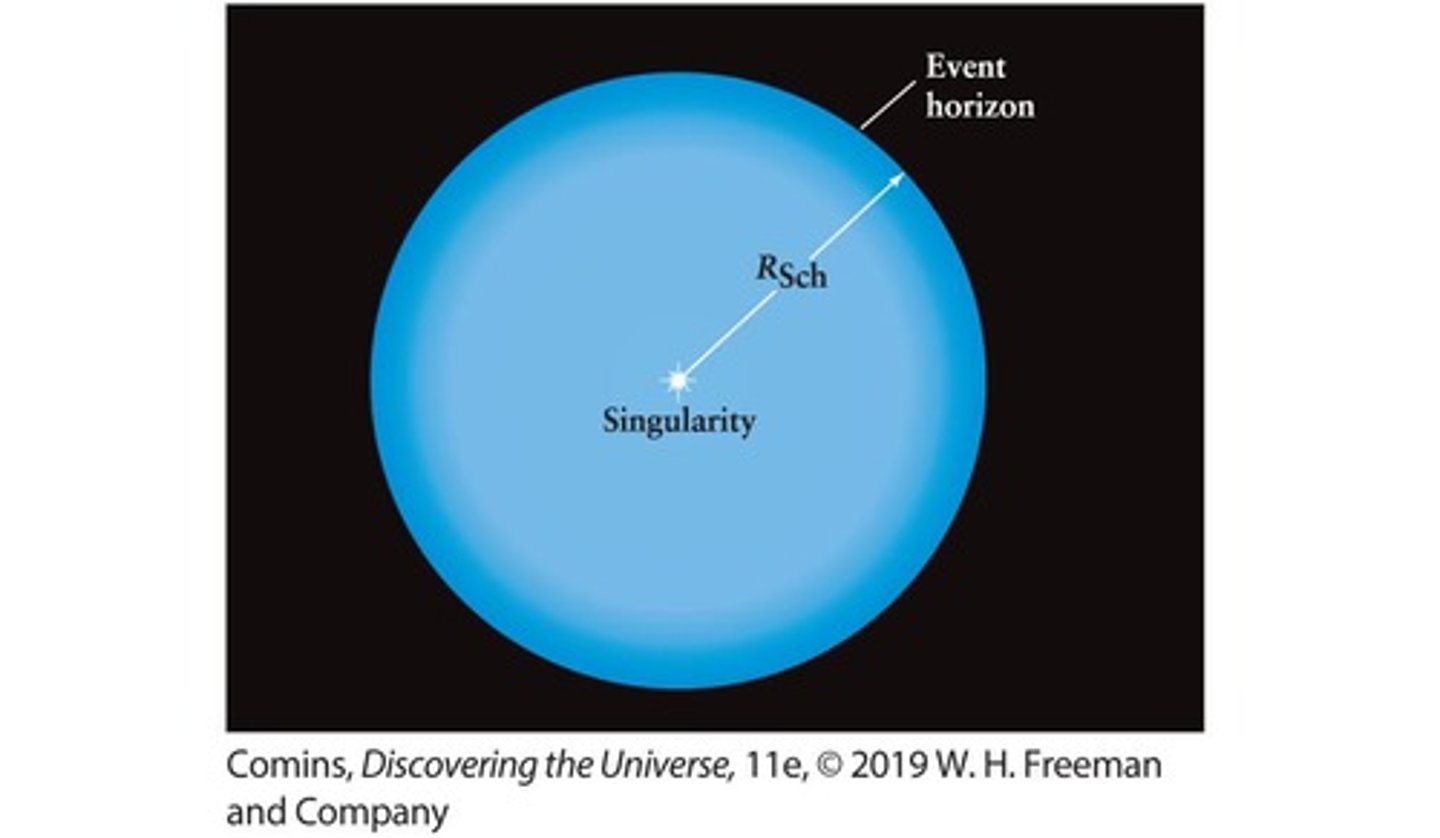
Matter density
The concentration of matter affects the curvature of spacetime and the gravitational force.
Newton's laws
Accurate only for objects with relatively small masses, slow velocities compared to the speed of light, and low densities.
Curved Spacetime
In the presence of matter, spacetime curves, changing the path of light rays and creating gravity.
Gravitational Redshift
The color of light from an object appears different at varying distances from a mass, with closer light sources appearing redder due to energy loss.
Mercury's perihelion precession
The change in Mercury's position closest to the Sun due to gravitational influences and curvature of space predicted by general relativity.
Event horizon
The boundary that separates a black hole from the rest of the universe.
Schwarzschild black holes
Nonrotating black holes formed when the mass creating them is not rotating.
Light deflection
The warping of space by matter causes light to change its path.
Eclipse observation
The first confirmation of general relativity occurred in 1919 when stars behind the Sun were observed during an eclipse.
Photon energy loss
Photons lose energy when leaving the vicinity of a massive object, resulting in redshift.
High-density objects
Newton's laws are limited to motion sufficiently far from high-density objects, such as neutron stars.
Mass and density effect
The higher density of Earth compared to the Moon contributes to the slowing of time on Earth.
Two types of black holes
Black holes can either rotate or not rotate.
Mass influence on time
The amount of mass affects the flow of time, with more massive objects causing greater time dilation.
Path of light
The curvature of spacetime changes the usual straight paths of light rays.
Precession inconsistency
The amount of precession of Mercury's orbit is inconsistent with predictions made by Newton's law of gravity alone.
Internal magnetic field loss
A characteristic of black holes where they lose their internal magnetic field.
Angular momentum retention
A black hole retains its angular momentum from before entering the black hole.
Electric charge retention
A black hole retains its electric charge from before entering the black hole.
Kerr black holes
Rotating black holes that possess angular momentum and collapse to a ring-shaped singularity located inside the black hole.
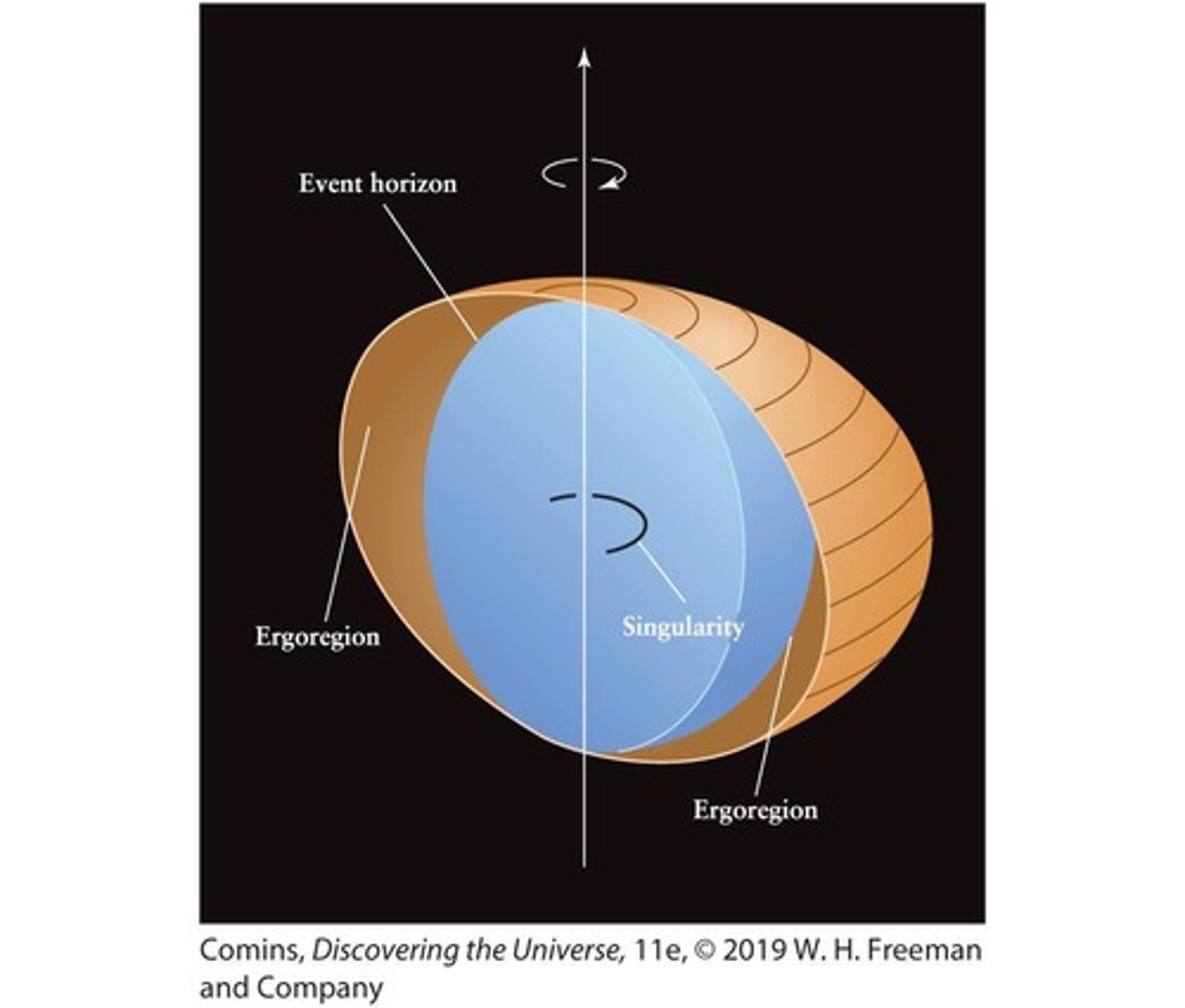
wormholes
Connections to other parts of space predicted by general relativity for Kerr black holes, which astrophysicists are skeptical of.
Trapping of Light
The phenomenon where light remains trapped inside a black hole, with most photons curving back in.
Schwarzschild radius
The distance from the center to the event horizon of a black hole.
singularity
The mass at the center of a black hole, which is so dense that it is referred to as a singularity.
ergoregion
A doughnut-shaped region just outside the event horizon of a Kerr black hole, where nothing can remain at rest.
accretion disk
A structure formed by the angular momentum of infalling gas and dust around a black hole.
gravitational radiation
Ripples in the fabric of spacetime generated by a pair of orbiting objects, traveling away at the speed of light.

tidal force
The difference in gravitational forces felt by different sides of an object near a black hole, causing it to stretch.
black hole
An astronomical object with a gravitational pull so strong that nothing, not even light, can escape from it.
nonrotating black hole
A black hole characterized by having only two notable features: its singularity and its event horizon.
light behavior near stars
The paths and colors of light rays departing from stars are affected very little by the star's gravitational force.
photons
Particles of light that can curve back into a black hole or become infinitely redshifted when escaping.
cube-shaped probe
An object used to illustrate the effects of tidal forces near a black hole, pulled long and thin by gravitational differences.
infalling matter
Matter that is drawn towards a black hole, experiencing extreme gravitational effects.
spacetime
The four-dimensional continuum that combines the three dimensions of space with the dimension of time.
main-sequence star
A star that is in the stable phase of its lifecycle, during which it fuses hydrogen into helium.
giant star
A star that has expanded and cooled after exhausting the hydrogen in its core.
supergiant star
An extremely large star that has evolved past the giant stage and has a very high luminosity.
PSR B1913+16
The period of the binary pulsar first observed by Hulse and Taylor has changed significantly since it was first observed in 1975.
LISA (Laser Interferometer Space Antenna)
LISA will have three satellites linked by laser beams that will enable scientists to detect tiny changes in the distance between the satellites when gravity waves pass through the space between them.
Stellar-remnant black holes
Detected in close binary star systems, examples include Cygnus X-1, LMC X-3, V404 Cygni, and A0620-00.
Cygnus X-1
A black hole with a mass of about 15 Mʘ and a companion star with a mass of 30 Mʘ.
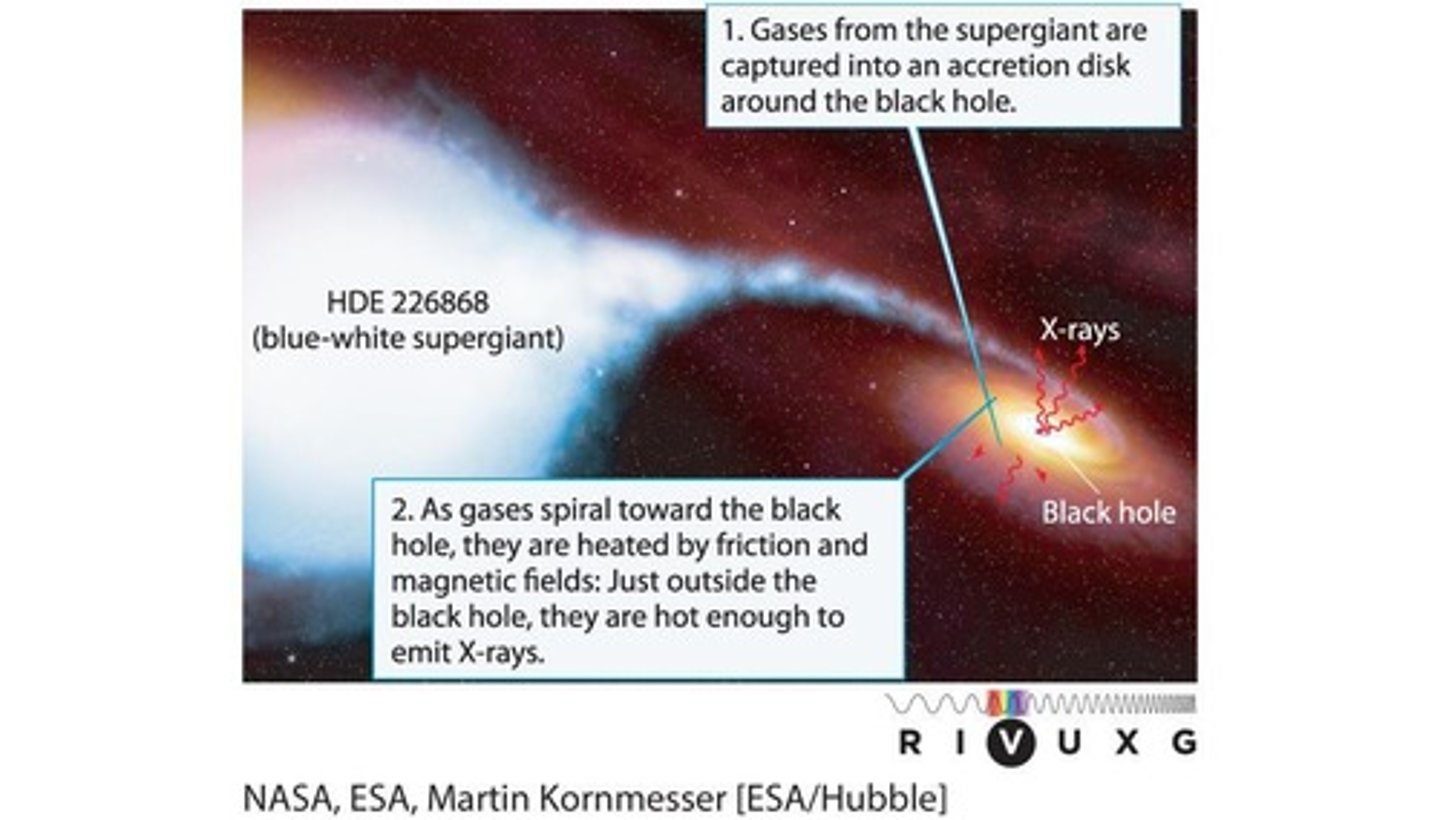
V404 Cygni
A black hole with a mass between 10-15 Mʘ and a companion star mass of approximately 0.6 Mʘ.
V461 Sgr
A black hole with a mass between 5.5-8 Mʘ and a companion star mass of approximately 10 Mʘ.
GS 2000+25
A black hole with a mass between 6-14 Mʘ and a companion star mass of approximately 0.7 Mʘ.
H 1705-250
A black hole with a mass between 6.4-6.9 Mʘ and a companion star mass between 0.3-0.6 Mʘ.
GRO J1655-40
A black hole with a mass of 7.02 Mʘ and a companion star mass of 2.34 Mʘ.
A 0620-00
A black hole with a mass between 5-10 Mʘ and a companion star mass between 0.2-0.7 Mʘ.
GS 1124-T68
A black hole with a mass between 4.2-6.5 Mʘ and a companion star mass between 0.5-0.8 Mʘ.
GRO J 042+32
A black hole with a mass between 6-14 Mʘ and a companion star mass of approximately 0.3 Mʘ.
4U 1543-47
A black hole with a mass between 2.7-7.5 Mʘ and a companion star mass of approximately 2.5 Mʘ.
Supermassive black holes
Most of these black holes have masses between 1 million and 20 billion solar masses, with the most massive known having 66 billion solar masses.
Intermediate-mass black holes
Formed from clusters of stars concentrated in a small volume, with masses between a few hundred and a million solar masses.
Primordial black holes
Formed during the explosive beginning of the universe, with masses ranging from a few grams to the mass of a planet.
Galaxy M87
The bright region in the center has stars and gas held in tight orbits by a black hole with a mass between 3.5 and 7.2 x 10^9 Mʘ.
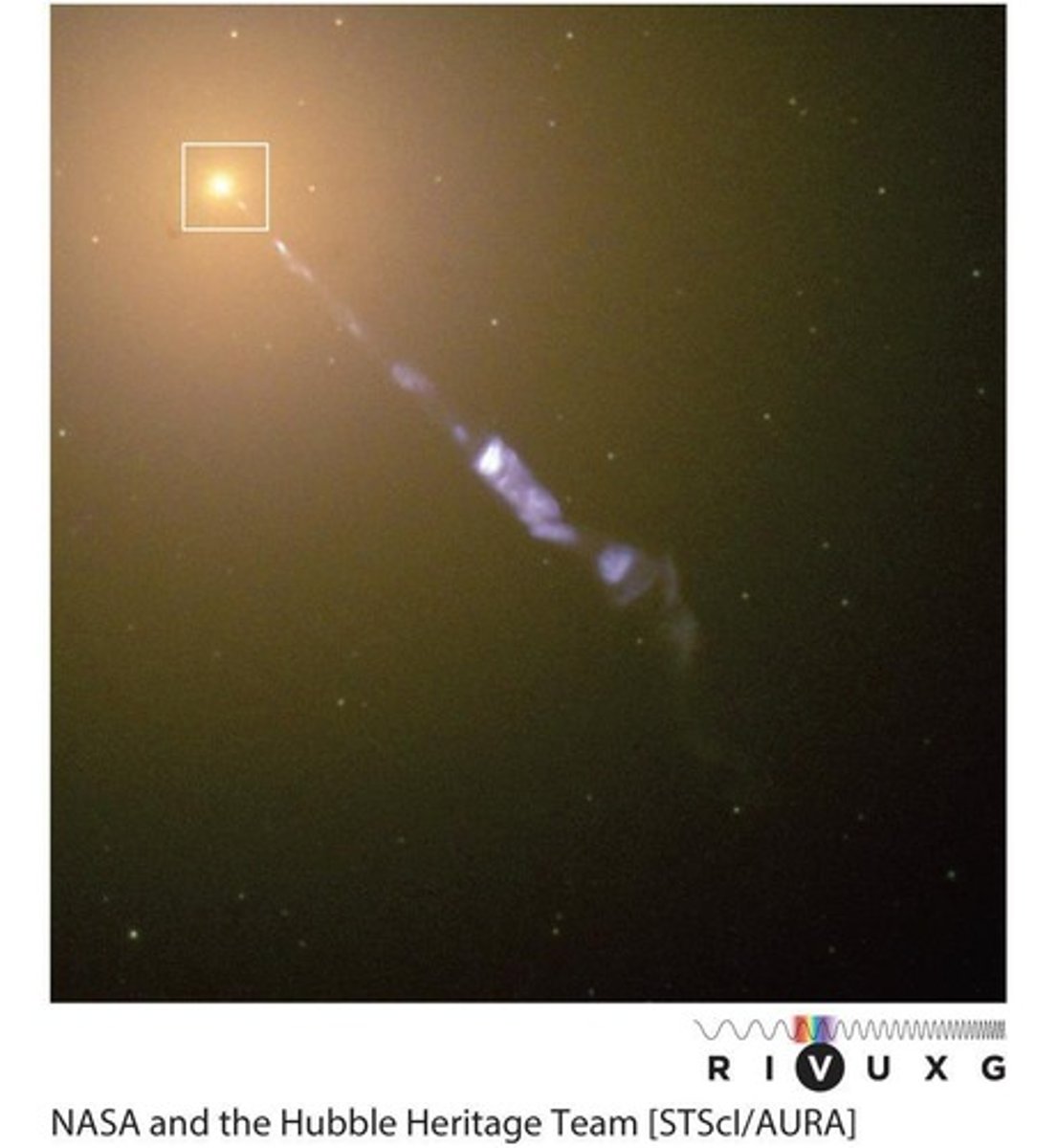
Disk of gas and dust in NGC 7052
Swirling around a 3 x 10^8 Mʘ black hole, this disk is 3700 ly across and will be consumed over the next few billion years.
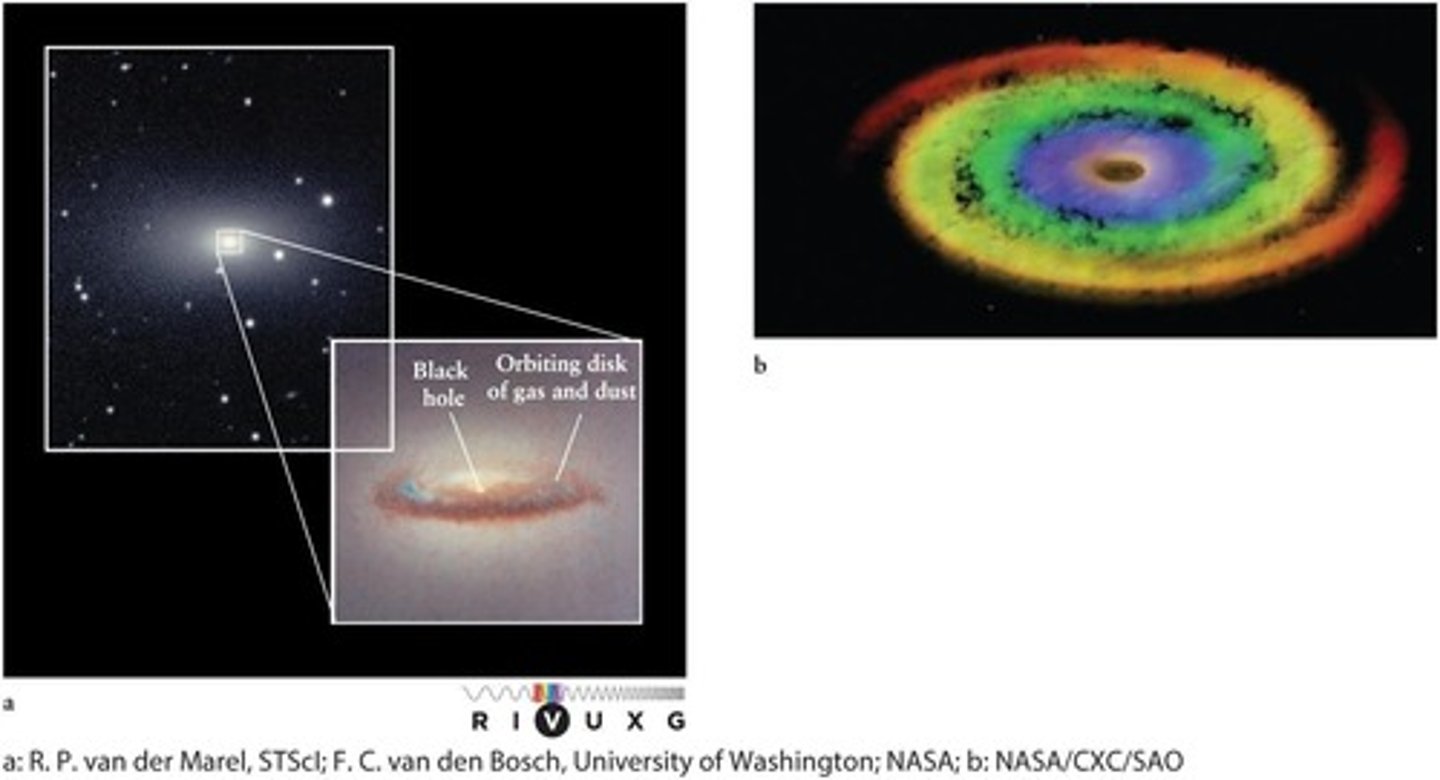
NGC 7052
A galaxy located 191 million light-years from Earth in the constellation Vulpecula.
Wien's Law
A law that describes the relationship between the temperature of an object and the wavelength of the peak emission of its thermal radiation.
Intermediate-Mass Black Hole
A type of black hole with a mass between stellar black holes and supermassive black holes, roughly 400 Mʘ in this context.
Chandra X-ray Telescope
A space telescope that observes X-rays from high-energy regions of the universe, including black holes.
Virtual Particles
Pairs of particles that spontaneously appear and disappear in a vacuum, not violating any laws of nature.
Electron (e-)
A subatomic particle with a negative electric charge.
Positron (e+)
The antimatter counterpart of the electron, with a positive electric charge.
Photons (γ)
Elementary particles that are the quantum of electromagnetic radiation, including light.
Mount Everest
The highest mountain on Earth, used here as a reference for the mass of primordial black holes.
Burst and Transient Source Experiment (BATSE)
An experiment aboard the Compton Gamma-ray Observatory that detected gamma-ray bursts.
Hubble Space Telescope
A space telescope that has provided high-resolution images of astronomical objects, including gamma-ray burst locations.
Swift Satellite
A NASA satellite designed to detect and observe gamma-ray bursts.
Light Output Variation
The change in brightness of a celestial object over time, such as the varying light output from a black hole.
Superheated Matter
Matter that has been heated to extremely high temperatures, often found in the accretion disk of a black hole.
Jets of Particles
Streams of particles ejected from a black hole, traveling at close to the speed of light.
Energy Measurement Colors
Colors used to indicate the total measured energy of gamma-ray bursts, with red being the brightest and violet the dimmest.
gamma-ray burst
Events believed to be caused by some supernovae and by the collisions of dense objects, such as neutron stars or black holes.
Hawking process
A process in which virtual particles near the black hole become real, decreasing the mass of the black hole until it disappears.
gravitational wave
Ripples in spacetime caused by certain movements of mass, detectable by gravity wave antennas.
Kerr black hole
A rotating black hole.
Schwarzschild black hole
A nonrotating black hole.
supermassive black hole
A black hole with a mass millions to billions of times that of the Sun, typically found at the center of galaxies.
primordial black hole
A black hole that may have formed at the beginning of the universe.
theory of special relativity
A theory that reveals that space and time are intimately connected and change with an observer's relative motion.
virtual particle
Particles that exist for a short time due to quantum fluctuations, which can become real near a black hole.